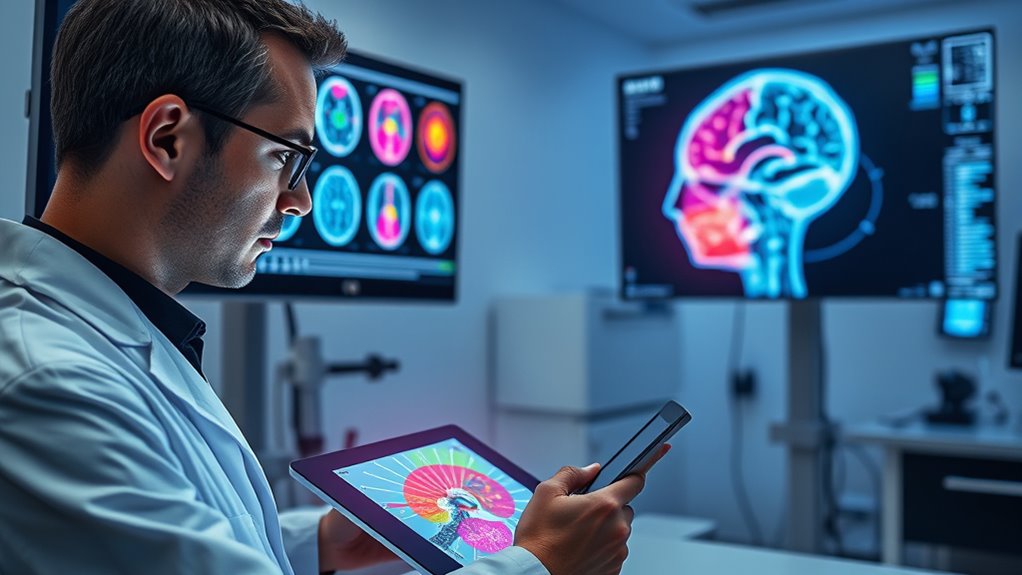AI uses advanced algorithms that analyze a mix of clinical, genetic, lifestyle, and imaging data to predict your stroke risk accurately. These models employ machine learning, neural networks, and ensemble methods, often achieving around 80% accuracy. They also incorporate real-world data and focus on transparency, so clinicians can trust the results and recommend personalized prevention strategies. If you keep exploring, you’ll discover how these innovations can transform stroke prevention and care for you.
Key Takeaways
- AI models leverage clinical, imaging, genetic, demographic, and lifestyle data to predict stroke risk accurately.
- Machine learning techniques, including neural networks and ensemble methods, enhance prediction performance over traditional tools.
- Model transparency and high data quality ensure reliable, explainable predictions suitable for clinical adoption.
- Performance metrics like AUC and F1 score validate AI models’ effectiveness in stroke risk stratification.
- AI-driven risk assessment supports personalized prevention strategies and improves early intervention outcomes.

Artificial intelligence is transforming how healthcare professionals assess stroke risk, enabling more accurate and early predictions. By leveraging advanced machine learning models, you can now analyze vast amounts of data to identify individuals at heightened risk more effectively than traditional methods. Neural networks and ensemble techniques, which combine multiple algorithms like gradient boosting trees (GBT) and Cox models, have demonstrated significant improvements in predicting cardiovascular events and stroke likelihood. These combined models can reach prediction accuracies of up to 80% in certain populations, giving clinicians a more reliable basis for intervention decisions.
Incorporating diverse data sources is key to enhancing these AI models. You can include clinical information such as medical history and vital signs, imaging data from scans, and even genetic profiles. This all-encompassing approach allows AI to consider multiple facets of a patient’s health, leading to more precise risk assessments. For example, genetic data can reveal predispositions that might otherwise go unnoticed, helping you identify high-risk individuals early. Demographic factors like age and gender, along with lifestyle choices such as diet and exercise habits, further refine the prediction process, ensuring no relevant risk factor is overlooked. Additionally, understanding model transparency principles can increase trust and facilitate clinical adoption of AI tools. Incorporating data quality practices can further enhance the reliability of these models, ensuring more consistent and trustworthy predictions.
AI techniques like deep learning with models such as Xception and EfficientNet have proven comparable to traditional scoring systems in predicting stroke risk. These models excel at capturing complex patterns in large datasets, providing nuanced insights into a patient’s likelihood of experiencing a stroke. To build trust and transparency, explainable AI (XAI) methods help clarify how predictions are made, making it easier for you and your patients to understand and accept the results. Additionally, data imputation techniques like random forest-based methods address missing information, improving dataset reliability and the robustness of your models. Incorporating real-world data can further enhance the applicability of AI models in diverse clinical environments.
Performance metrics such as the area under the ROC curve (AUC) and F1 scores help you evaluate how well these AI models perform. Higher AUC values indicate better discrimination between high- and low-risk patients, while F1 scores approaching 88% in combined models highlight their precision. Ensemble methods, which combine multiple models, often outperform individual algorithms, leading to more accurate predictions. When compared to traditional risk assessment tools, AI models consistently show superior discrimination, calibration, and overall accuracy. Moreover, ongoing validation studies are essential to ensure these models maintain accuracy across diverse populations and clinical settings.
You can also leverage AI to identify and quantify various risk factors. This includes integrating clinical findings, genetic predispositions, demographic details, lifestyle habits, and comorbid conditions like hypertension and diabetes. Such all-encompassing analysis enables a holistic view of a patient’s stroke risk, guiding targeted preventive strategies. As AI continues to evolve and integrate seamlessly into healthcare systems, you’ll be better equipped to stratify risk, personalize interventions, and ultimately reduce the burden of stroke through early, informed decision-making. Additionally, understanding the sound design principles behind data visualization can improve how these predictive insights are communicated to both clinicians and patients, making complex information more accessible.
Frequently Asked Questions
How Does AI Improve Traditional Stroke Risk Assessments?
You might wonder how AI enhances traditional stroke risk assessments. AI improves accuracy by analyzing vast, diverse data sets, like electronic health records, lifestyle factors, and genetics, which traditional methods often overlook. It identifies hidden patterns and risk factors, differentiates stroke types, and incorporates real-time biomarkers. This allows you to get personalized, early interventions, ultimately reducing stroke risks more effectively than conventional assessments.
What Are the Limitations of AI in Predicting Strokes?
Ever wonder why AI predictions aren’t foolproof? You see, AI’s limitations lie in data quality and variability—your models may struggle across different healthcare settings. Complex algorithms can be hard to interpret, making clinical trust difficult. Plus, privacy concerns and the need for extensive resources hinder widespread use. Ultimately, these challenges mean AI still needs refinement before it can reliably predict strokes and seamlessly fit into your healthcare decisions.
Can AI Models Adapt to Individual Patient Data Over Time?
You might wonder if AI models can adapt to your changing health data over time. The good news is, yes—they can. AI systems process ongoing medical information from your EHRs, wearables, and diagnostics, updating their predictions as your condition evolves. This continuous learning helps personalize your risk assessments, making interventions more accurate and timely, ultimately supporting better health management tailored specifically to you.
What Privacy Concerns Exist With Ai-Driven Stroke Risk Tools?
Imagine a vault guarding your most precious treasures—your health data. With AI-driven stroke risk tools, privacy concerns are like potential breaches in this vault. You worry about unauthorized access, data sharing, and how your sensitive information is protected. Ensuring encryption, consent, and compliance act as the vault’s sturdy locks, keeping your data safe. Transparency and ethical use build trust, making sure your health secrets stay protected within the secure vault.
How Accessible Are Ai-Based Stroke Prediction Systems Worldwide?
You might wonder how accessible AI-based stroke prediction systems are worldwide. Currently, their availability varies greatly. In some regions, advanced infrastructure and high-quality data make deployment easier, but in others, limited resources, poor data quality, and lack of technological infrastructure hinder access. Socioeconomic disparities and policy support also influence reach, meaning many communities still face significant barriers to benefiting from these innovative healthcare tools.
Conclusion
You might find it surprising how AI’s predictive power aligns with your own health journey. Just as a chance encounter can change your perspective, AI’s insights could unexpectedly alert you to stroke risks before symptoms appear. Embracing this technology isn’t just about data—it’s about seizing that coincidence of opportunity. By trusting AI, you could be one step ahead, turning a random moment into a proactive step toward a healthier future.











